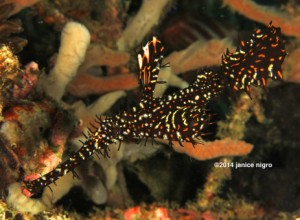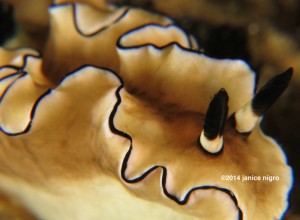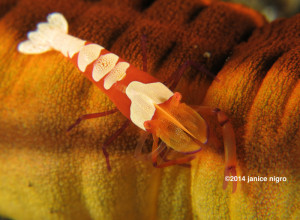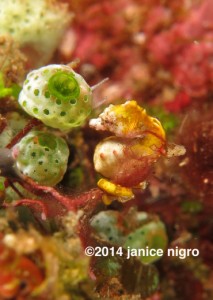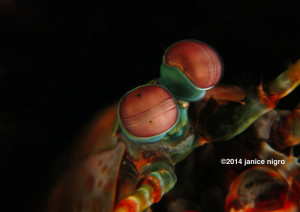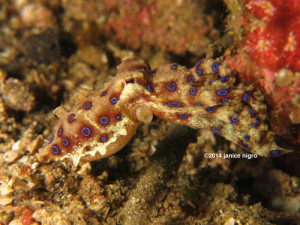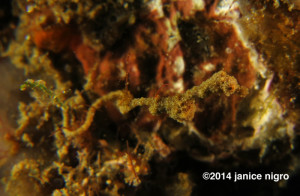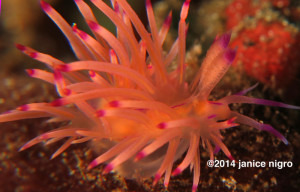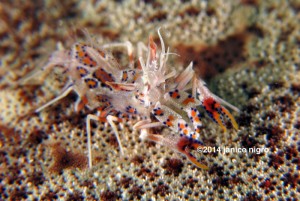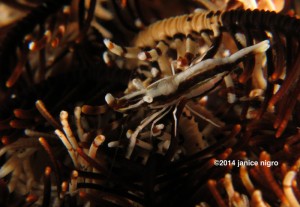News
Secret wishes at Kungkungan Bay
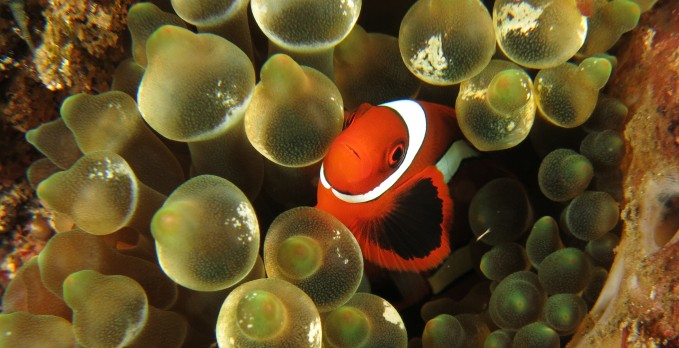
I noticed the other day that my second pair of flip-flops this year is becoming worn out. The first pair only lasted about six weeks. Contemplating the lifespan of your flip-flops seems like something a truly mindless person would do, unless you spent the previous seven years in a place where it rained nearly every day, confining your feet to waterproof footwear of some sort almost always. The state of my flip-flops, then, has been perhaps an unusual reminder that I am moving ahead in my life. Or at least in my “swimabout”.
I reach this important milestone in my life/swimabout while in a place called Kungkungan Bay at Kungkungan Bay Resort (KBR) just outside of Bitung, Indonesia, which is a city famous for processing tuna. It appears that I am not so busy if I have time to speculate about the significance of my flip-flops, but really I am, at least in a scuba diver, traveler, photographer kind of way.
We start diving by 8:15, and dive again at 11:15, and 14:45, and if you want, you can have all the shore dives that you would like. If you are awake for that. Each dive is preceded by a dive briefing that is accompanied by an illustration on a white board. The guides describe the general geography of a site, sandy slope, wall, rubble, and indicate what kind of critters we might find. When the dive guide gets to the part where he tells us how long it takes to arrive at the dive site, we laugh every time because usually it is only five to seven minutes and sometimes less.
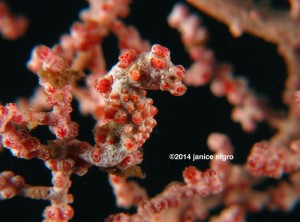 Kungkungan Bay is on Lembeh Strait where the highlight of your day may be diving a site called Hairball. Lembeh Strait is famous for the type of diving called muck diving. It is what it sounds like, diving in muck, the bottom, which might include some local refuse, and yet Lembeh is on most divers’ wish list because all sorts of fabulous, unusual and colorful creatures, with sometimes whirling parts (that may be their eyes), live there. Many probably have yet to be discovered. Why they do live in such a habitat is a mystery to me – it is a busy and sometimes noisy area – but for some reason they seem to love to inhabit the rubble or the garbage that floats into the sea and reproduce in it.
Kungkungan Bay is on Lembeh Strait where the highlight of your day may be diving a site called Hairball. Lembeh Strait is famous for the type of diving called muck diving. It is what it sounds like, diving in muck, the bottom, which might include some local refuse, and yet Lembeh is on most divers’ wish list because all sorts of fabulous, unusual and colorful creatures, with sometimes whirling parts (that may be their eyes), live there. Many probably have yet to be discovered. Why they do live in such a habitat is a mystery to me – it is a busy and sometimes noisy area – but for some reason they seem to love to inhabit the rubble or the garbage that floats into the sea and reproduce in it.
As a well-read diver, you can arrive at a resort in Lembeh Strait with a long list of creatures that you want to see. There is a wish list board at KBR and some critters are 100% guaranteed, like pygmy seahorses, whereas others are not, such as a hairy frogfish or harlequin shrimp. I do not like to make lists of critters because I feel sure then that I will not see them. But KBR is really like a make-a-wish place for divers. The guides will say there is no guarantee – they are always saying this – but they pretty much can find whatever you have read about (except perhaps a mermaid, which was an actual request written on the wish list board).
Sea creatures tend to be territorial and in the case of KBR, so do the dive guides. My dive guide for part of the week was Ade, who has been working for the resort for nearly 18 years. His colleague, Liberty, had been there almost 19 years! Together they have logged over 25,000 dives. I am not sure who expects to see who underwater. The critters may themselves have special names for these two, something elegant I am sure, not hairy and juvenile together. It was always fun to dive with them because they still like to do it, and they do it with a sense of humor. One day my camera was out of my reach and so it was handed to Ade. “Show me the critters,” he said. One of his colleagues told me to show him anything, just anything. Of course, he handed the camera to me immediately, before we descended, so I had no chance to show him that I could find a pygmy seahorse before he did.
Secretly however, I did have a list…one creature that I had never seen was the blue-ringed octopus, an animal with one of the most potent venoms on earth. I do not exactly understand what it is they eat for it to be necessary to deliver such a potent venom because they are not that big. Of course it might be necessary because of what they are afraid of. After many years of diving muck sites, on my first dive in Lembeh, the 8:15 dive at Pulau Abadi, a blue-ringed octopus went gliding across the bottom in front of us. It was skillfully placing each of its legs in succession across the bottom (without disturbing the sand) and any obstacles in the way, like some kind of an extraordinary Olympic runner whose upper body never changes positions even though his legs are furiously working underneath. The iridescent blue rings were not always on display, but just a swish of your hand in the water above it would cause it to flash them on and off. It seems like a dangerous game to play because a bite that we might not even feel could kill us (and it is not that big). But it was hard not to be hypnotized by such a creature because it is both beautiful and intricate.
I had a second wish…to see a Lembeh sea dragon. This one though I did not keep a secret. I did not say “I want to see one”, or write it boldly on the board, but I said instead, “how often do you see them?” One day Ade instructed us to entertain ourselves underwater at Nudi Retreat 3 because he was going to focus on finding a Lembeh sea dragon. Sure I thought, this will be one of those dives like a blue water dive where you have high hopes and you see nothing. He quickly showed us a hairy squat lobster and an estuarine stonefish, the kind that looks like a sunken shipwreck. Then he led us to the wall at Nudi Retreat 3 and began to progressively scan through each section of it, oblivious to the other diver and me. If you try this yourself, which I did, you start to discover a lot of creatures. I found a super tiny flabellina.
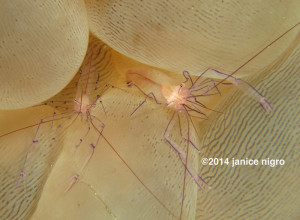 And then Ade made his underwater call from his lips, a kind of Three Stooges sounding wowowo. I came to learn that it would be something pretty sensational when he makes that sound. The other diver got to him first so I entertained myself with a beautiful closed anemone that was nearby. I had no idea what it would be. When it was my turn to look, a Lembeh sea dragon was bouncing around in the water in front of me, like a tiny rubber band attached to something at one end. I observed it and tried to photograph it, but other divers from the other groups also wanted a chance. It was a very short two minutes with the sea dragon. I really wanted to stay and see how it would spend its day, where it would go, if it would travel far from that spot (I did not get the GPS coordinates… ). I still do not know how often the guides find the sea dragons, but I am glad I was with Ade on one of the days that he did.
And then Ade made his underwater call from his lips, a kind of Three Stooges sounding wowowo. I came to learn that it would be something pretty sensational when he makes that sound. The other diver got to him first so I entertained myself with a beautiful closed anemone that was nearby. I had no idea what it would be. When it was my turn to look, a Lembeh sea dragon was bouncing around in the water in front of me, like a tiny rubber band attached to something at one end. I observed it and tried to photograph it, but other divers from the other groups also wanted a chance. It was a very short two minutes with the sea dragon. I really wanted to stay and see how it would spend its day, where it would go, if it would travel far from that spot (I did not get the GPS coordinates… ). I still do not know how often the guides find the sea dragons, but I am glad I was with Ade on one of the days that he did.
Early December seemed to be a shoulder season of sorts for the resort (perhaps I should keep this observation a secret!), and the management bumped me up to a deluxe bungalow on the beach. Extremely luxurious accommodations, especially for a single traveler. The area though has a high density of resorts, so sometimes we had to go to another dive site because there already were boats from other places. Once, however, we scheduled a dive to Angel’s Window 15 minutes ahead of time to beat the other boats, but there are plenty of other incredible dive sites so you are never disappointed. There is always a plan A, B, C, D etc., which are in essence always an “A” plan. The only dive that did not work was the mandarin fish dive. Plenty of some of the largest mandarin fish I have ever seen, but no mating pairs. I still had my own dive guide for most days, and one day I was completely alone on the dive boat for three dives. For only two days did I have to share Ade with one other guest. He was a nice man from Singapore who seemed to have a nervous habit of constantly checking the air of the other divers, especially female ones, and to take their photo underwater. While it is good to have such a conscientious dive buddy, one that sticks close to you, it is not ever a good hair day underwater.
The one bad part about being at a resort as opposed to a liveaboard for diving is that guests come and go at different times, so the party is not over for everyone at the same time. It is already difficult to meet people and to see them go even when departing at the same time, but to leave when the others are going out for a dive, like to Hairball, is tough.
I had to leave there today. For a while, I will think about what is happening at 8:15, 11:15, and 14:45 in another small part of the world. And if I am lucky enough to go there again, I am 100% guaranteed to find Ade and Liberty.
Blogs
Northern Red Sea Reefs and Wrecks Trip Report, Part 2: Wall to Wall Wrecks

Jake Davies boards Ghazala Explorer for an unforgettable Red Sea diving experience…
The second day’s diving was a day full of wreck diving at Abu Nuhas, which included the Chrisoula K, Carnatic, and Ghiannis D. The first dive of the day was onto the Chrisoula K, also known as the wreck of tiles. The 98m vessel remains largely intact where she was loaded with tiles which can be seen throughout the hold. The stern sits at 26m and the bow just below the surface. One of the highlights of the wreck is heading inside and seeing the workroom where the machinery used for cutting the tiles are perfectly intact. The bow provided some relaxing scenery as the bright sunlight highlighted the colours of the soft coral reef and the many reef fish.

Following breakfast, we then headed to the next wreck, which was the Carnatic. The Carnatic is an 89.9m sail steamer vessel that was built in Britain back in 1862. She ran aground on the reef back in 1869 and remains at 27m. At the time, she was carrying a range of items, including 40,000 sterling in gold. An impressive wreck where much of the superstructure remains, and the two large masts lay on the seafloor. The wooden ribs of the hull provide structures for lots of soft corals, and into the stern section, the light beams through, bouncing off the large shoals of glass fish that can be found using the structure as shelter from the larger predators that are found outside of the wreck.

The final wreck at Abu Nuhas was the Ghiannis D, originally called ‘Shoyo Maru,’ which was 99.5m long and built in Japan back in 1969 before becoming a Greek-registered cargo ship in 1980. The ship then ran aground on the reef on April 19th, 1983, and now sits at the bottom at a depth of 27m. Heading down the line, the stern of the ship remains in good condition compared to the rest of the hull. The highlight of the wreck, though, is heading into the stern section and down the flights of stairs to enter the engine room, which remains in good condition and is definitely worth exploring. After exploring the interior section of the ship, we then headed over to see the rest of the superstructure, where it’s particularly interesting to see the large table corals that have grown at the bow relatively quickly considering the date the ship sank. After surfacing and enjoying some afternoon snacks, we made sure everything was strapped down and secured as we would be heading north and crossing the Gulf of Suez, where the winds were still creating plenty of chop.

The next morning, it was a short hop to Ras Mohammed Nature Reserve for the next couple of days of diving. The 6am wake-up call came along with the briefing for the first site we would be diving, which was Shark & Yolanda. The low current conditions allowed us to start the dive at Anemone City, where we would drift along the steep, coral-filled wall. These dives involved drifts, as mooring in Ras Mohammed wasn’t allowed to protect the reefs. As a dive site, Shark & Yolanda is well-known and historically had a lot of sharks, but unfortunately not so many in recent years, especially not so early in the season. However, there was always a chance when looking out into the blue.

The gentle drift took us along the steep walls of the site, with plenty of anemone fish to be seen and a huge variety of corals. It wasn’t long into the dive before we were accompanied by a hawksbill turtle, who drifted with us between the two atolls before parting ways. Between the two reefs, the shallow patch with parts of coral heads surrounded by sand provided the chance to see a few blue-spotted stingrays that were mainly resting underneath the corals and are always a pleasure to see. With this being the morning dive, the early sunlight lit up the walls, providing tranquil moments. Looking out into the blue, there was very little to be seen, but a small shoal of batfish shimmering underneath the sunlight was a moment to capture as we watched them swim by as they watched us.

Towards the end of the dive, we stopped at the wreck of the Jolanda where the seafloor was scattered with toilets from the containers it was carrying. This provided a unique site to make a safety stop, which was also accompanied by a large barracuda slowly swimming by, along with a hawksbill turtle calmly swimming over the reef as the sun rays danced in the distance.
For the next dive, we headed north to the Strait of Tiran to explore the reefs situated between Tiran Island and Sharm El Sheik, which were named after the British divers who had found them. We started on Jackson before heading to Gordons Reef, where we also did the night dive. All the atolls at these sites provided stunning, bustling coral reefs close to the surface and steep walls to swim along, which always provided the opportunity to keep an eye out for some of the larger species that can be seen in the blue. Midwater around Jackson Reef was filled with red-toothed triggerfish and shoals of banner fish, which at times were so dense that you couldn’t see into the blue. Moments went by peacefully as we enjoyed the slow drift above the reef, watching these shoals swim around under the mid-afternoon sun.

The night dive at Gordon’s Reef was mainly among the stacks of corals surrounded by sand, which was great to explore under the darkness. After some time circling the corals, we came across what we were really hoping to find, and that was an octopus hunting on the reef. We spent the majority of the dive just watching it crawl among the reef, blending into its changing surroundings through changes in colour and skin texture. It’s always so fascinating and captivating to watch these incredibly intelligent animals, in awe of their ability to carry out these physical changes to perfectly blend into the reef. Before we knew it, it was time to head back to the boat to enjoy a well-deserved tasty dinner prepared by the talented chefs onboard.
Check in for the 3rd and final part of this series from Jake tomorrow!
To find out more about the Northern Red Sea reef and wrecks itineraries aboard Ghazala Explorer, or to book, contact Scuba Travel now:
Email: dive@scubatravel.com
Tel: +44 (0)1483 411590
Photos: Jake Davies / Avalon.Red
Marine Life & Conservation
Double Bubble for Basking Sharks

 The Shark Trust is excited to announce that, for two more days only, all donations, large or small, will be doubled in the Big Give Green Match Fund!
The Shark Trust is excited to announce that, for two more days only, all donations, large or small, will be doubled in the Big Give Green Match Fund!
Donate to Basking in Nature: Sighting Giants
The Shark Trust is hoping to raise £10k which will be doubled to £20k. This will go towards Basking in Nature: Sighting Giants. And they need YOUR help to reach they’re goal.
The Shark Trust’s citizen science project is to monitor and assess basking sharks through sightings; encouraging data collection, community engagement, and promoting nature accessibility. This initiative aims to enhance health and wellbeing by fostering a deeper connection with British Sharks.
Campaign Aims
- Increase citizen science reporting of Basking Sharks and other shark sightings to help inform shark and ray conservation.
- Provide educational talks about the diverse range of sharks and rays in British waters and accessible identification guides!
- Create engaging and fun information panels on how to ID the amazing sharks and rays we have on our doorstep! These can be used on coastal paths around the Southwest. With activities and information on how you can make a difference for sharks and rays!
- Promote mental wellbeing through increasing time in nature and discovering the wonders beneath the waves!
Donate, and double your impact. Click Here
-

 News3 months ago
News3 months agoHone your underwater photography skills with Alphamarine Photography at Red Sea Diving Safari in March
-

 News3 months ago
News3 months agoCapturing Critters in Lembeh Underwater Photography Workshop 2024: Event Roundup
-

 Marine Life & Conservation Blogs2 months ago
Marine Life & Conservation Blogs2 months agoCreature Feature: Swell Sharks
-

 Blogs2 months ago
Blogs2 months agoMurex Resorts: Passport to Paradise!
-

 Blogs2 months ago
Blogs2 months agoDiver Discovering Whale Skeletons Beneath Ice Judged World’s Best Underwater Photograph
-

 Gear Reviews2 months ago
Gear Reviews2 months agoGear Review: Oceanic+ Dive Housing for iPhone
-

 Marine Life & Conservation2 months ago
Marine Life & Conservation2 months agoSave the Manatee Club launches brand new webcams at Silver Springs State Park, Florida
-

 News3 months ago
News3 months agoWorld’s Best Underwater Photographers Unveil Breathtaking Images at World Shootout 2023


